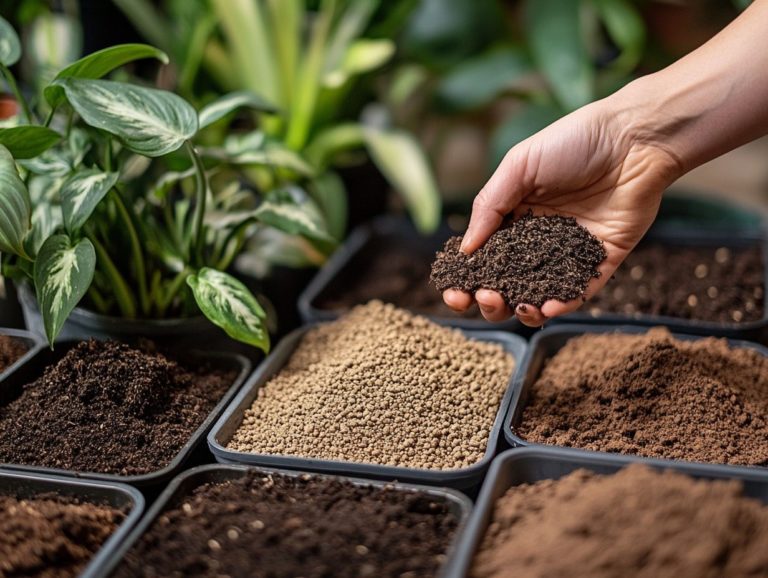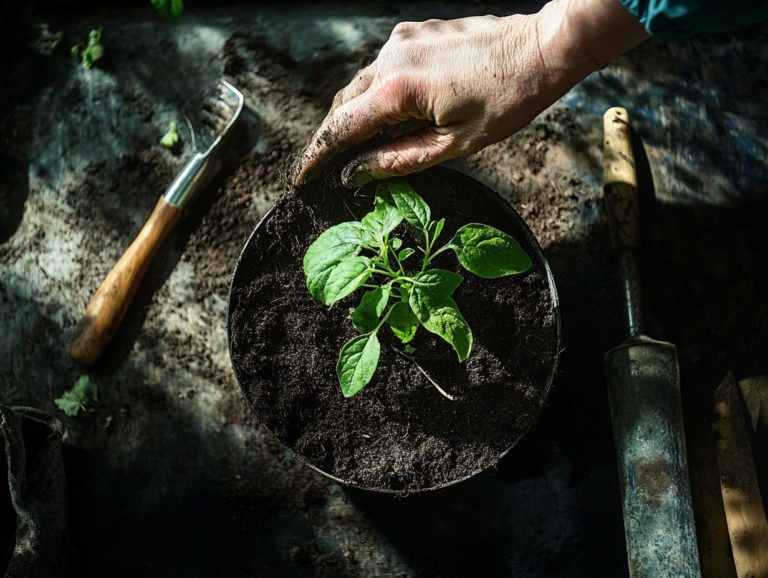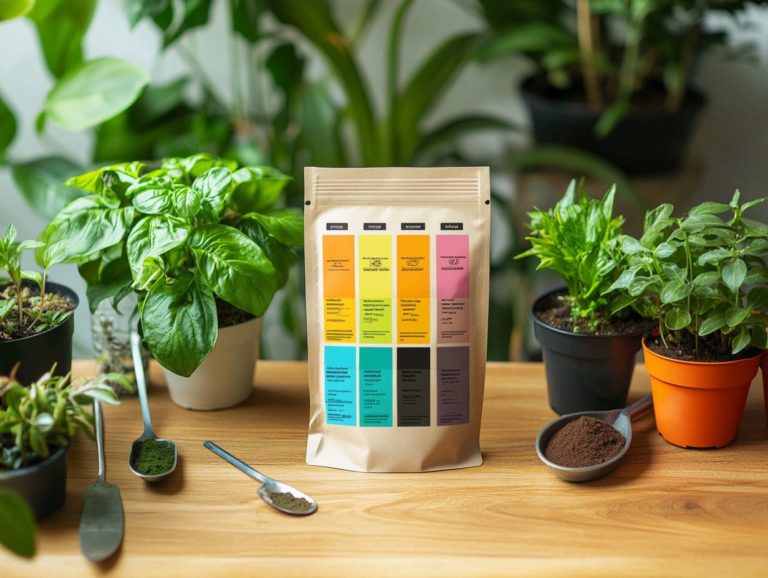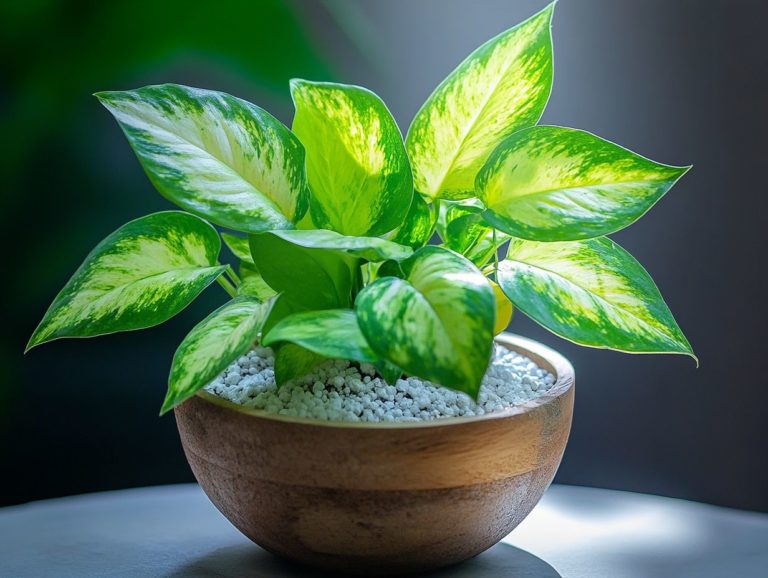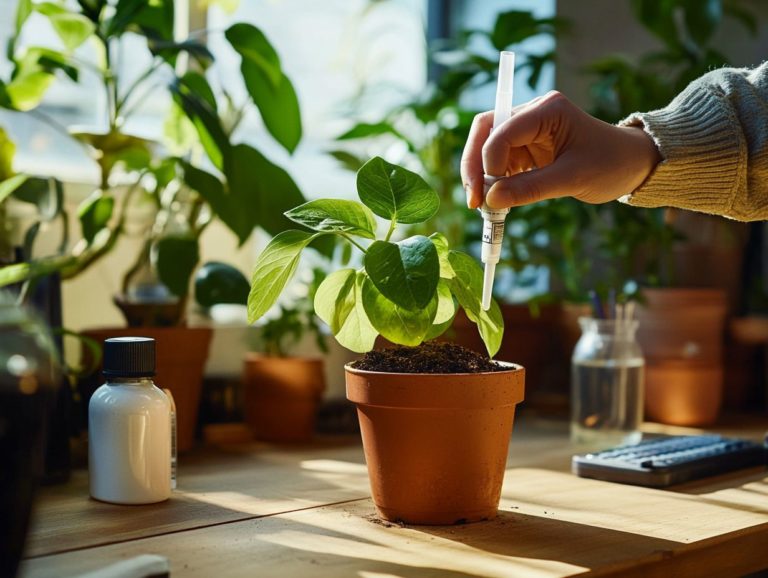5 Essential Soil Care Tips for Indoor Plants
Indoor plants have a remarkable ability to enliven any space. However, ensuring their vitality demands a touch of expertise. Are you ready to transform your indoor garden into a thriving oasis? Get ready to discover five essential soil care tips that every plant parent must know!
You’ll learn how to select the ideal soil, master effective watering techniques, and understand your plants’ nutritional requirements. All these tips aim to craft the perfect environment for their flourishing growth.
We will also explore common soil challenges and the advantages of opting for organic solutions. Don t wait to give your plants the care they deserve!
Contents
- Key Takeaways:
- 1. Choosing the Right Soil for Your Indoor Plants
- 2. Understanding the Nutritional Needs of Your Plants
- 3. Proper Watering Techniques
- 4. Fertilizing Your Indoor Plants
- 5. Spot & Solve Soil Problems Fast!
- How Often Should You Repot Your Indoor Plants?
- What Are the Benefits of Using Organic Soil for Indoor Plants?
- What Are Some Natural Ways to Improve Soil Quality?
- How Can You Tell If Your Indoor Plants Need More Nutrients?
- What Are Some Signs of Overwatering or Underwatering Your Indoor Plants?
- Frequently Asked Questions
Key Takeaways:
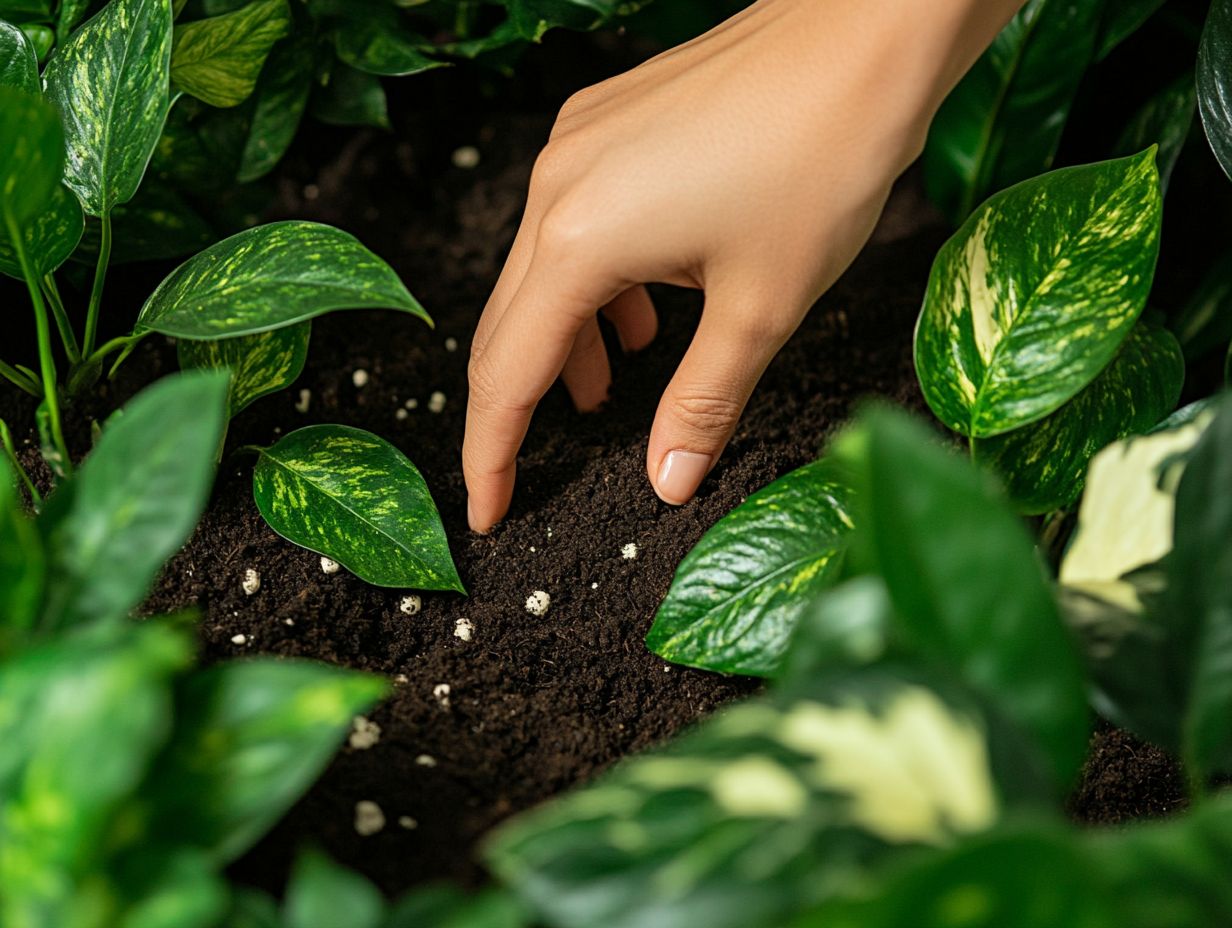
Here are your key takeaways to ensure your indoor plants thrive:
- Choose the right soil for your indoor plants to ensure proper drainage and aeration for healthy root growth.
- Understand your plant’s nutritional needs and provide appropriate fertilization to promote growth and prevent deficiencies.
- Proper watering techniques, such as checking the soil moisture and using room temperature water, are crucial for indoor plant health.
1. Choosing the Right Soil for Your Indoor Plants
Choosing the right soil for your indoor plants is essential for their growth and overall health. Proper soil ensures adequate drainage, aeration, and nutrient availability, which are vital for maintaining vibrant houseplants like succulents, cacti, and African violets.
Each houseplant has its own set of requirements. Understanding these nuances can greatly influence their well-being. For example, succulents and cacti thrive in sandy, well-draining mixes, while African violets prefer a lighter, moisture-retentive blend.
Experts highlight that organic soil options, such as those enriched with compost or peat, can enhance plant growth by supplying essential nutrients. When selecting the right soil blend, consider factors like pot size and climate conditions to create an optimal environment for each species to flourish.
2. Understanding the Nutritional Needs of Your Plants
Understanding the nutritional needs of your houseplants is vital for fostering their optimal growth and health. Different plants, like pothos, philodendron, and rubber plants, require specific nutrients that impact their growth rate and vitality.
Essential nutrients like nitrogen, phosphorus, and potassium play critical roles in photosynthesis, root development, and overall resilience. Fertilizers supply these necessary components, ensuring your plants receive proper nourishment.
By observing changes in growth patterns and leaf coloration, you can gauge the health of your indoor greenery. A balanced nutrient approach tailored to each plant type is essential for maintaining a lush, thriving collection. Additionally, avoiding the top 7 mistakes in watering indoor plants is crucial for nurturing your indoor plants effectively.
3. Proper Watering Techniques
Proper watering techniques are essential for keeping your houseplants in prime condition. By understanding their specific needs, you can prevent issues like root rot and overwatering that often lead to pest infestations.
Different indoor plants have unique requirements. Succulents thrive in drier conditions, while tropical plants prefer a consistently moist environment. To ensure proper care, consider trying 5 unique watering techniques for exotic plants. Look for signs of overwatering, such as yellowing leaves or a mushy stem.
Humidity levels play a significant role in a plant s hydration needs. In high humidity, watering becomes less frequent, whereas a dry climate could require you to check moisture levels more often. Keeping those leaves clean can greatly enhance your plants’ health by improving photosynthesis; a gentle wipe with a damp cloth can work wonders!
4. Fertilizing Your Indoor Plants
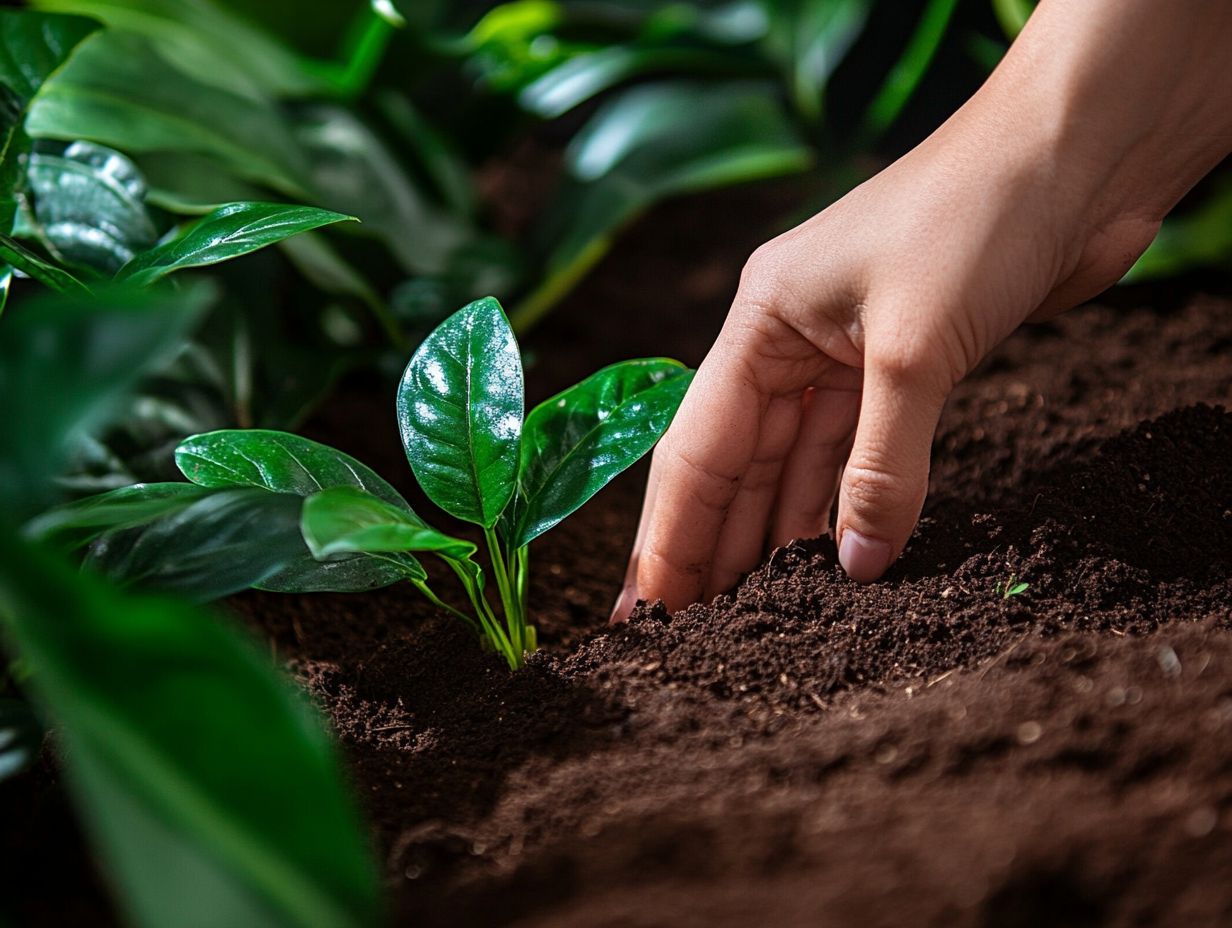
Fertilizing your indoor plants correctly is crucial for providing them with the essential nutrients they need for healthy growth. This is especially true for popular houseplants like the peace lily, aloe vera, and snake plant. Each of these plants has unique fertilization requirements based on their growth rates.
For example, liquid fertilizers are often recommended for quicker nutrient absorption. They are ideal for fast-growing species like the peace lily, which thrives with monthly applications during the growing season. In contrast, slow-release fertilizers are better for less demanding plants like the snake plant. This plant benefits from applications every six to eight weeks.
Expert Andrea Beck emphasizes that understanding these distinctions is vital for crafting a customized fertilization routine that enhances vitality. This way, each plant gets just the right fuel to grow strong and healthy while avoiding the pitfalls of over-fertilization.
5. Spot & Solve Soil Problems Fast!
Identifying and addressing soil issues in your indoor plants is essential for preventing problems like root rot and pest infestations. These issues could jeopardize their health and ensure they flourish in optimal conditions.
Common soil problems, such as compaction and lack of nutrients, can significantly impede plant growth. When soil becomes compacted, it restricts root expansion, making it hard for your plants to absorb essential water and nutrients. A lack of nutrients reveals itself through yellowing leaves or stunted growth, indicating the soil is missing vital elements. To accurately diagnose these issues, consider conducting a soil test or simply pay attention to the overall health of your plants.
Repotting with fresh, nutrient-rich soil can breathe new life into your plants. Implementing effective pest control measures helps keep harmful invaders at bay, ultimately maintaining their vibrant condition. Additionally, exploring innovative watering techniques for indoor plants can further enhance their health and vitality.
How Often Should You Repot Your Indoor Plants?
Determining how often you should repot your indoor plants depends on their unique growth rates and the space available for their roots to stretch. Many houseplants typically need repotting every 1-2 years to thrive.
Watch for signs that it’s time to repot. If you notice stunted growth where your plant seems to barely hang on despite your best care or if the roots peek out of the drainage holes or wrap tightly around the root ball, it’s a clear sign that repotting is in order.
Andrea Beck notes that grasping the right timing and techniques for repotting can significantly boost your plant’s health. For many varieties, repotting right after flowering or during the spring is often ideal, as that’s when the plant gears up for its active growth phase.
By paying attention to these signs, you not only enhance the vibrancy of your indoor garden but also contribute to the overall well-being of your beloved plants.
What Are Some Common Soil Problems for Indoor Plants?
Common soil problems for your indoor plants might include compacted soil, nutrient deficiencies, and root rot all of which can stem from overwatering and poor drainage. These issues make your plants more vulnerable to pests.
These challenges can manifest in various ways; you might notice stunted growth, yellowing leaves, or wilting foliage. These signals indicate that your plant isn’t receiving the care it needs to thrive. Compacted soil restricts root expansion and limits access to oxygen, while a lack of nutrients can lead to pale or discolored leaves. To address nutrient deficiencies, learn how to fertilize your indoor plants effectively. Root rot, often a consequence of excess moisture, can sap your plant’s vigor and even lead to its demise if not addressed quickly.
Act quickly to tackle these issues! Ensure your potting mix is well-aerated. Choose appropriate fertilizers to significantly boost soil health. Regularly check for drainage and water only when necessary to fend off pests and nurture a flourishing indoor garden.
Start your journey to a vibrant indoor garden today!
What Are the Benefits of Using Organic Soil for Indoor Plants?
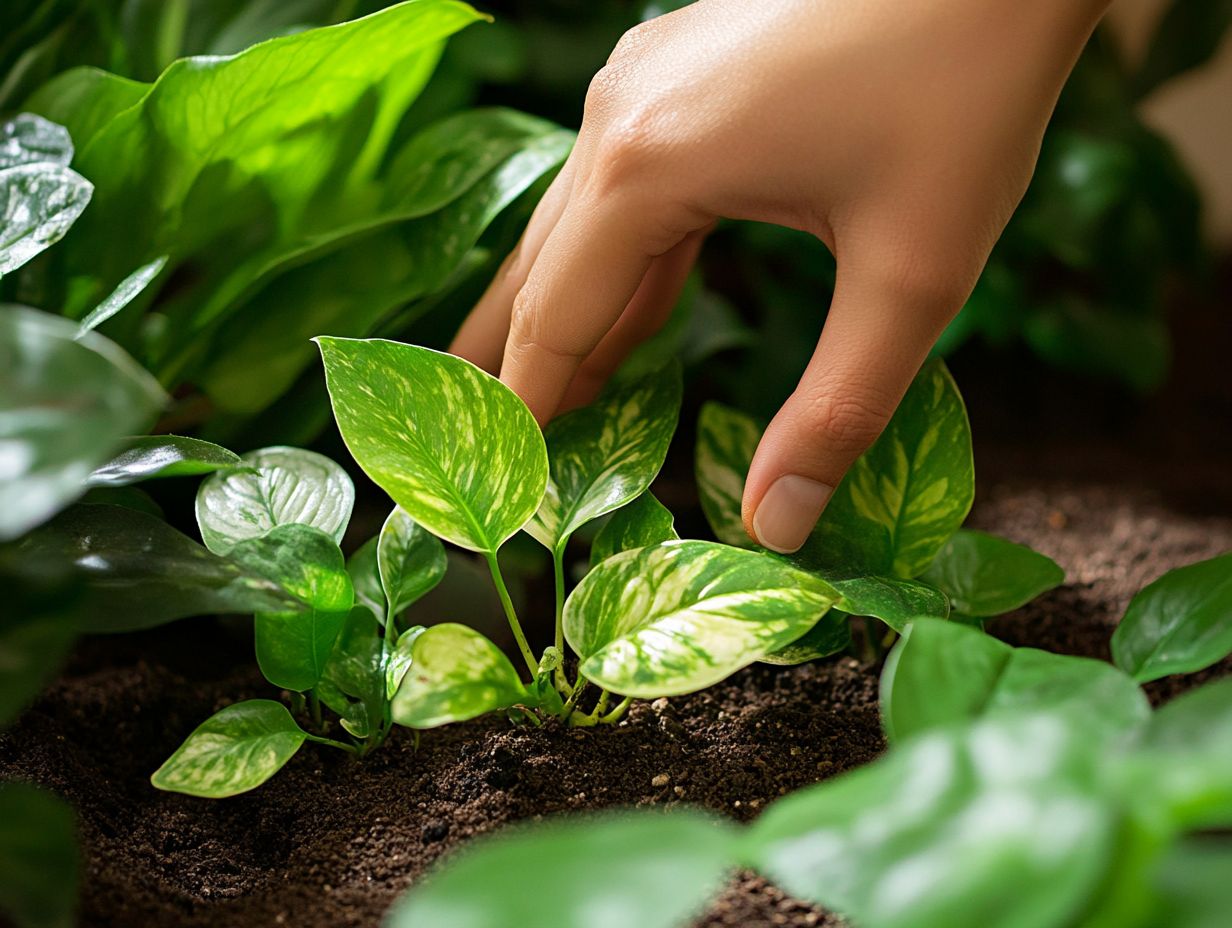
Using organic soil for your indoor plants brings a wealth of benefits. You’ll enjoy improved nutrient retention and enhanced drainage. This creates a thriving ecosystem for beneficial microorganisms, resulting in healthier, more robust houseplants and a reduced reliance on synthetic fertilizers.
When selecting organic soil, consider factors like texture and composition. These can significantly impact the health and growth of your plants. To enhance your understanding, refer to understanding soil pH for indoor plants. Look for soil that includes compost, peat moss, or coconut coir. These components help ensure proper aeration and moisture retention.
Tailoring your soil choices to meet the specific needs of different plants is essential. For instance, succulents flourish in sandy mixes. In contrast, ferns thrive in moisture-rich formulas. If you’re caring for orchids, consider following 5 expert tips for watering orchids indoors. You can also boost your plants by adding organic fertilizers. Natural options, like worm castings or fish emulsion, provide essential nutrients without the worry of chemical buildup.
A thoughtful approach to soil and fertilization is crucial for cultivating vibrant indoor foliage.
What Are Some Natural Ways to Improve Soil Quality?
Improving soil quality naturally is vital for keeping your houseplants healthy. You can achieve this through methods like adding organic matter and mulching.
Incorporating compost not only enriches the soil with essential nutrients but also boosts microbial activity. This creates a vibrant ecosystem right in your pot. Worm castings, packed with beneficial bacteria and enzymes, enhance nutrient availability and help retain moisture, ensuring your plants receive a steady water supply.
Using mulch is another smart move. It regulates soil temperature and minimizes water evaporation. This effectively protects your plant roots from extreme conditions. These amendments are vital for promoting overall soil health, which directly influences the vitality and growth of your houseplants.
Healthy soil serves as the foundation for flourishing plants, making these practices essential for anyone passionate about plant care.
How Can You Tell If Your Indoor Plants Need More Nutrients?
Determining whether your indoor plants need a nutrient boost involves keen observation of specific signs. Look out for yellowing leaves and stunted growth. Unusual leaf drop especially in popular houseplants like philodendron and snake plant can indicate a deficiency.
If you notice brown tips on the leaves or a loss of vibrant color, that means your plants are craving some essential nutrients for vibrant growth! Weak or leggy stems? That’s your cue to consider adding a balanced fertilizer. Regularly checking for these symptoms allows you to intervene promptly, ensuring your plants receive the nutrition they need to thrive. Additionally, be aware of watering myths about indoor plants that could affect their health.
Don’t forget to monitor soil moisture and pH levels. These factors are crucial for maintaining optimal health. Be proactive and understand the specific needs of each plant type. For effective care, consider learning about the best watering techniques for indoor plants. This way, you can transform your indoor space into a flourishing oasis.
What Are Some Signs of Overwatering or Underwatering Your Indoor Plants?
Recognizing the signs of overwatering or underwatering your indoor plants is essential for their survival. Symptoms like wilting, yellowing leaves, and root rot can dramatically impact their health and growth.
Understanding the delicate balance of moisture is key since each plant type has its own specific water requirements. For example, succulents and cacti thrive in drier conditions, while ferns and tropical plants crave consistent moisture. To help you care for these varieties effectively, check out these 5 tips for watering low-light plants.
Overwatering often shows up as mushy or discolored roots and unwanted mold. In contrast, underwatering results in crispy, dry leaves and stunted growth. To prevent these issues, opt for well-draining soil and pots with drainage holes. Additionally, consider using 5 essential tools for indoor plant watering to help maintain the right moisture levels.
Establish a consistent watering routine tailored to each plant’s unique needs. If problems do arise, simply assess the moisture level and adjust your watering frequency to bring your plants back to their optimal condition.
Frequently Asked Questions
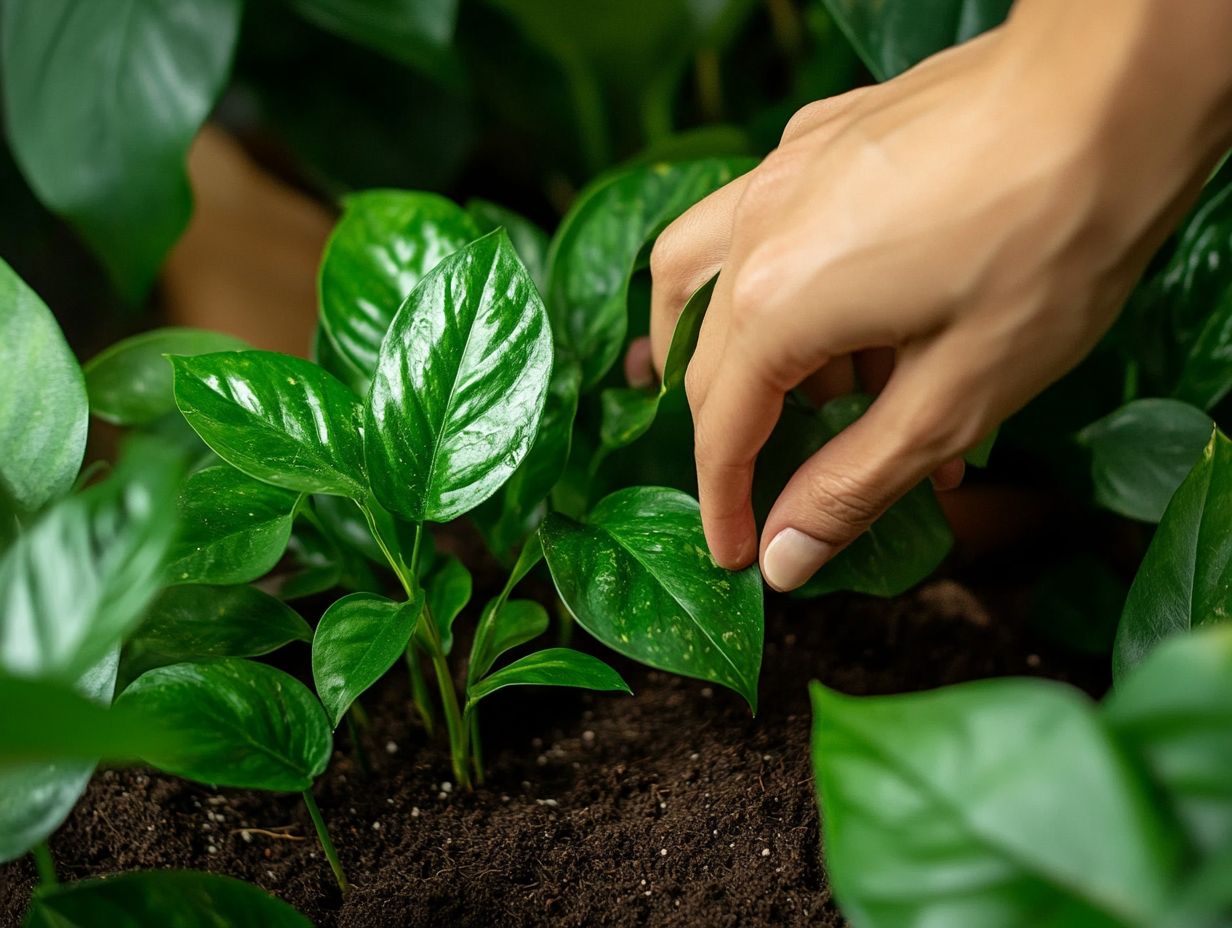
1. What are the 5 essential soil care tips for indoor plants?
Excited to care for your indoor plants? Here are the 5 essential tips:
- Use high-quality potting soil.
- Choose a well-draining pot.
- Water appropriately.
- Fertilize regularly.
- Repot when necessary.
These practices ensure your indoor plants thrive.
2. Can I use regular soil for my indoor plants?
No, regular soil is not ideal for indoor plants. It may contain pests, diseases, and weed seeds. Regular soil also lacks the necessary nutrients and drainage that indoor plants require.
3. How often should I water my indoor plants?
The frequency of watering your indoor plants depends on factors like the type of plant, pot size, and environment. Generally, it s recommended to water once a week. Always check the moisture level of the soil before watering.
4. Do I need to fertilize my indoor plants?
Indoor plants need regular fertilization because they lack access to natural nutrients in the soil. Use a slow-release fertilizer or organic fertilizers for the best results.
5. When should I repot my indoor plants?
You should repot when your plants become root-bound. This means their roots fill the pot and have no space to grow. Signs include slow growth, yellowing leaves, and roots growing out of the drainage holes.
6. Can I reuse potting soil for my indoor plants?
It is not recommended to reuse potting soil for your indoor plants. It may contain depleted nutrients, pests, and diseases. Use fresh potting soil each time you repot your plants.


